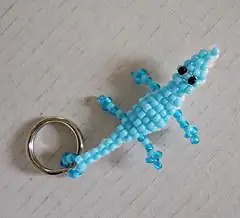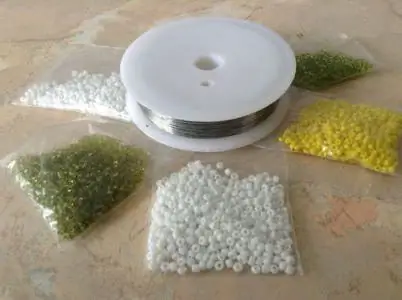
Inhaltsverzeichnis:
- Autor Sierra Becker [email protected].
- Public 2024-02-26 04:45.
- Zuletzt bearbeitet 2025-01-22 22:11.
Blühende Gänseblümchen lassen selten jemanden gleichgültig. Zarte, bescheidene Blumen, wie kleine Sonnen, bringen Sie zum Lächeln und wärmen Sie mit Wärme. Perlengänseblümchen helfen, ein Stück Sommer zu bewahren. Eine Ansteckblume aus diesen Blumen schmückt ein festliches Outfit oder eine Tasche, und ein Blumenstrauß belebt den Raum. Sie sind einfach zu bedienen, sodass selbst ein Anfänger die Arbeit erledigen kann.
Arbeitsmaterialien
Es gibt verschiedene Techniken, um Perlengänseblümchen herzustellen. Jeder von ihnen benötigt die gleichen Materialien.
Perlen in den Farben Weiß, Gelb und Grün. Sie können ein kleines Kaliber oder ein größeres nehmen - je nach Wunsch.
Dünner Draht zum Auffädeln. Es sollte seine Form gut beh alten. Außerdem benötigen Sie einen dickeren Draht für den Vorbau. Es kann durch Stricknadeln, Bambusspieße, gebrauchte Kugelschreiberminen und andere Abfallmaterialien ersetzt werden.

Du brauchst grünes Blumenklebeband, um den Stiel einzuwickeln. Sie können es durch gleichfarbige Fäden oder einen dünnen Streifen ersetzenWellpapier. Damit die Wicklung gut hält, muss sie am Anfang und am Ende mit PVA-Kleber verklebt werden.
Du brauchst auch Werkzeuge: Drahtschneider und Schere.
Der einfachste Weg
Der einfachste Weg, Perlengänseblümchen zu machen, ist Schleifen. Sogar ein Kind kann problemlos damit umgehen. Es eignet sich zur Herstellung kleiner Blumen.
Fädeln Sie 25 weiße Perlen auf einen 40 cm langen Draht. Lassen Sie die Spitze für 5 s stehen und führen Sie das lange Ende des Drahtes durch die erste Perle. Ziehen Sie die Schlaufe. Habe das erste Blütenblatt. Fädeln Sie erneut 25 Perlen auf und führen Sie die erste Perle erneut durch, sodass eine zweite Schleife entsteht. Sie sollten möglichst nahe beieinander liegen. Mache also 7 Blütenblätter.
Nehmen Sie für den Kern eine gelbe Perle. Fädeln Sie es auf einen 15 cm langen Draht und drehen Sie die Enden, indem Sie es in die Mitte legen.
Stecken Sie den Kern in die Mitte des Rohlings mit Blütenblättern und umgeben Sie ihn gleichmäßig, um eine Blume zu bilden. Befestigen Sie die Enden des Drahtes und drehen Sie ihn bis zum Ende.

Jetzt müssen wir ein Kelchblatt machen. Fädeln Sie 9 grüne Perlen auf ein 40 cm langes Stück Draht und machen Sie eine Schleife ähnlich den Blütenblättern, indem Sie sie durch die erste Perle fädeln. Fahren Sie mit dem Muster fort. Bilden Sie 6 solcher Schleifen. Befestige die Kelchblätter unter der Blüte und verdrille die Enden des Drahtes.
Blätter verleihen dem Stängel Volumen. Sie können auf die gleiche Schleifenart hergestellt werden. Wählen Sie 9 grüne Perlen auf einem 30 cm langen Draht, f alten Sie eine Schlaufe fünf Zentimeter vom Rand entfernt. Scrollen Sie ein paar Mal in eine Richtung. Machen Sie die nächste Schleife im Abstand von 0,5 cm von der ersten. Bilden Sie eine ungerade Anzahl von Blättern. F alten Sie den Draht in der Mitte und lassen Sie die mittlere Schlaufe in der Mitte. Fangen Sie an zu drehen und verteilen Sie die Blätter paarweise.
Nun bleibt noch die Montage abzuschließen. Um die Blume, die bereits aus Kern, Blütenblättern und Kelchblättern zusammengesetzt ist, beginnen Sie, den grünen Faden in dichten Reihen zu wickeln. Blätter nicht vergessen.
Diese einfachen Gänseblümchen können für Sommerschmuck, Grußkarten, Schmuckkästchen und Geschenke verwendet werden.
Diese perlenbesetzten Gänseblümchen werden nicht groß, weil sie sich schnell verformen.
Hell und einfach
Eine weitere einfache Option, die auf der Schleifentechnik basiert, sieht sehr beeindruckend aus. Nachfolgend finden Sie eine Schritt-für-Schritt-Anleitung. Kamille aus Perlen und Pailletten. Diese Methode ist einfach, aber das Produkt ist voluminöser.
Auf 15 cm Draht Paillettenperlen 9 Stück in Reihe auffädeln. Anfang und Ende jeder Reihe - 2 Perlen. Drehen Sie den Draht zu einem Ring, lassen Sie das Ende 5 cm und wählen Sie weitere 13-15 Paare auf die gleiche Weise. Die zweite um die erste Schlaufe verteilen und fixieren. Es stellt sich ein Blütenblatt heraus, das aus zwei Reihen besteht. So entstehen 5-7 einzelne Blütenblätter.
Blätter werden auf die gleiche Weise gebildet. Sie können 2-3 Reihen machen und die Anzahl der Perlen stetig erhöhen.
Der Kern besteht aus einer gelben Perle. In diesem Fall ist kein Kelchblatt erforderlich, da das Produkt bereits voluminös ist. Um die Blume zusammenzubauen, verbinden Sie die Blütenblätter mit dem Kern, drehen Sie den Draht und befestigen Sie die Blätter. Den Stiel dekorieren.
Nachdem Sie einen solchen Blumenstrauß gesammelt haben, können Sie ihn in einem kleinen installierenVase. Oder in einen Topf "pflanzen" und mit einer Gipsmischung füllen. Ein solcher Blumenstrauß wird ein schönes Geschenk und eine schöne Innendekoration sein.

Parallelweben
Gänseblümchen, die mit der Parallelwebtechnik hergestellt wurden, können größer als die oben beschriebene Option gemacht werden. Ihre Höhe kann 45 cm erreichen, es ist besser, größere Perlen zu wählen.
Die Blüte besteht aus zwei Reihen unterschiedlich großer Blütenblätter.
Schema für die untere Reihe: Wählen Sie an einem 35 cm langen Draht 5 Perlen. Verteilen Sie sie in der Mitte. Führen Sie ein Ende durch die letzten 3 Perlen zum anderen. Es ergeben sich zwei Reihen aus 2 und 3 Perlen, und die Enden des Drahtes schauen in entgegengesetzte Richtungen. Wählen Sie als nächstes 4 Perlen an einem Ende und fädeln Sie das andere Ende zum Treffen. Bis zu 9 Reihen, Zifferblatt 4 Stück, 10 Reihen - 3 Stück, 11 Reihen - 2 Stück, 12 Reihen - 1 Stück. Drehen Sie die Enden. Ich habe ein Blütenblatt. Du musst 9 davon machen.
Schneiden Sie 35 cm Draht ab. Führen Sie es durch die letzte Perle (12. Reihe) jedes Blütenblatts und sammeln Sie sie alle in einem Ring. Sammeln Sie die Enden aller Drähte in einem Bündel. Aber nicht verdrehen.
Die obere Reihe besteht aus kleineren Blütenblättern. Sie werden nach folgendem Schema hergestellt. 1 Reihe - 2 Perlen; 2-reihig - 3 Stk.; 3, 4, 5, 6, 7 Reihen - jeweils 4 Perlen; 8-reihig - 3 Stk.;, 9-reihig - 2 Stk.; 10 Reihen - 1 Stck. Als letzte Perle alle Blütenblätter auf 35 cm Draht auffädeln und zu einem Ring f alten. Lassen Sie das Drahtbündel unverdreht.

Kamillenherz mit Perlen, die Meisterklasse ist unten angegeben. Für seine Herstellung werden 40 cm benötigtDrähte und gelbe Perlen. Sie müssen eine Schleife machen. Wickeln Sie dazu den Draht um Ihren Finger und lassen Sie an einem Ende 5 cm frei. Fädeln Sie 3 Perlen an einem kurzen Ende und 5 an einem langen Ende auf. Befestigen Sie die Reihen fest aneinander und machen Sie zwei Windungen mit dem Draht. Fädeln Sie weitere 5 Perlen auf und schrauben Sie sie unter die untere Perle. Es stellt sich heraus, dass die erste Reihe sozusagen in einem Ring aus zwei Bögen liegt. Wählen Sie für die nächste Reihe 9 Perlen auf jedem Bogen und fixieren Sie sie. Biegen Sie den resultierenden Kreis leicht, um ihm Volumen zu verleihen. Verbinden Sie die Schleife, die am Anfang gemacht wurde, mit dem Ende des Drahtes und drehen Sie sie unter dem Kern.
Kelchblätter werden in Schleifenform hergestellt, wie bei Perlengänseblümchen, deren Meisterklasse ganz am Anfang beschrieben wird.
Blätter
Blätter können so gemacht werden. Wählen Sie auf 45 cm Draht 5 grüne Perlen und platzieren Sie sie in der Mitte. Führen Sie ein Ende durch 2, 3, 4 und 5 Perlen. Es stellt sich heraus, "Zauberstab". Wählen Sie an einem Ende des Drahts 5 Perlen und fädeln Sie sie durch 4 Perlen, machen Sie dasselbe am anderen Ende. Es stellt sich heraus drei Zweige. Verbinden Sie die Enden des Drahtes und fädeln Sie 5 Perlen darauf. Teilen Sie erneut und wählen Sie jeweils 6 Perlen. Also mehrmals wiederholen. Wenn der zentrale Stiel rekrutiert ist, müssen Sie jeweils 5 Stück auffädeln und jedes Mal eine Perle an den Zweigen anbringen. Drehen Sie die Enden. Es stellt sich ein Blatt heraus, das wie ein flacher Fichtenzweig aussieht. Für eine Kamille reichen 3 Blätter.
Damit die Blume ihre Form gut behält, müssen Sie einen kleinen Rohling machen. Schneiden Sie aus einer Plastikflasche einen Kreis mit einem Durchmesser von 2 cm in einem Abstand von 2 mm ausKanten mit einer heißen Ahle, um Löcher in gleichem Abstand voneinander zu machen. Die Anzahl der Löcher entspricht der Anzahl der Blütenblätter. Machen Sie ein weiteres Loch in der Mitte für den Kern. Setzen Sie die vorbereiteten Blütenblätter und die Mitte ein und fädeln Sie den Draht von oben nach unten ein. Rauche den Stiel unter dem Plastikkreis. Schrauben Sie die Kelchblätter von unten und noch tiefer - die Blätter. Damit sich die Kamille nicht verbiegt, muss der Stiel mit einem dicken Draht verstärkt werden. Wickeln Sie Blumenband oder Faden darüber.

Diese Blumen sind gut in einer Vase.
Französische Gänseblümchen
Eine weitere Variante von Perlengänseblümchen ist das französische Weben. Sie können sowohl klein als auch groß gemacht werden. Fädeln Sie eine gerade Anzahl Perlen (30) auf ein Stück Draht. Lassen Sie ein Ende 5 cm stehen und bilden Sie eine Schleife, die ihm eine längliche Form verleiht. Die Hälfte der Perlen (15) auf das lange Ende auffädeln, mit Draht genau in der Mitte der vorherigen Reihe befestigen und ein paar Umdrehungen machen. Wählen Sie dann 15 weitere Teile und befestigen Sie sie unten. Ein Blütenblatt ist fertig. Der Rest wird auf die gleiche Weise ausgeführt. Für eine Blume werden mindestens 7 Stück benötigt. Verbinden Sie alle Blütenblätter zu einem Ring, indem Sie die Drahtenden verdrehen. Sie können die Rohlinge leicht biegen, um die gewünschte Form zu erh alten.
Für den Kern können Sie eine der vorherigen Optionen verwenden oder eine Perle oder einen Fleischknopf mit gelben Perlen flechten. Ein Kelchblatt aus 6-7 Blättern wird in Schleifenform hergestellt.
Blätter können auf die gleiche Weise wie Blütenblätter oder mit einer der oben beschriebenen Optionen hergestellt werden.

Kamillenfeld
So einfach ist dasverschiedene Gänseblümchen aus Perlen machen. Fotos von Blumen dienen als Inspiration. Sie können jede der Optionen ausprobieren. Blumen können sowohl klein als auch groß gemacht werden. Es hängt alles von der gewählten Webmethode und den Wünschen ab. Aus solchen Blumen lassen sich nicht nur Blumensträuße und Ansteckblumen herstellen, sondern auch stilvoller Schmuck.
Empfohlen:
Perlenkette - Webmuster. Schmuck aus Perlen und Perlen

Hausgemachtes ist nie aus der Mode gekommen. Sie sind ein Indikator für guten Geschmack und ein hohes Maß an Können des Mädchens. Wenn Sie nicht wissen, wie man eine Perlenkette herstellt, können Sie dieses Problem jederzeit mit Hilfe von Meisterkursen und vorgefertigten Schemata lösen, die im Artikel vorgestellt werden
Wie man auf verschiedene Arten eine Katze aus Perlen macht

Bevor du eine perlenbesetzte Katze machst, musst du entscheiden, welche Art von Dekoration du machen möchtest. Volumetrisch oder nichtvolumetrisch? Was wird es sein - eine Brosche oder eine Stickerei? Die Arbeit mit Perlen hat je nach Ausführungstechnik ihre eigenen Nuancen
Fliederweben aus Perlen - Schemata. Perlen für Anfänger

Die Kunst des Perlenstickens gibt es seit Tausenden von Jahren. Und in den letzten Jahren ist es wieder populär geworden. Die Menschen entdecken gerne die Welt der Handarbeit, lieben dieses alte Handwerk
Wie macht man ein Krokodil aus Perlen? Volumensicken. Schema eines Krokodils aus Perlen

In diesem Artikel werden wir uns überlegen, wie man aus Perlen ein Krokodil macht - ein originelles Souvenir. Es gibt viele Möglichkeiten für seine Herstellung. Der Artikel wird volumetrische Perlenarbeiten beschreiben, da jeder weiß, dass solche Figuren interessanter sind
Wie man Blumen aus Perlen webt: Diagramme, Fotos für Anfänger. Wie man Bäume und Blumen aus Perlen webt?

Perlenarbeiten, die von akribischen Nadelfrauen geschaffen wurden, haben noch niemanden gleichgültig gelassen. Es braucht viel Zeit, um Innendekorationen zu machen. Wenn Sie sich also für eine davon entscheiden, lernen Sie von einfachen, um die Grundprinzipien des Webens von Blumen aus Perlen zu beherrschen
